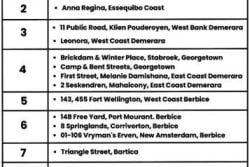Government last week asked for the Bank of Guyana’s intervention to address a foreign exchange shortage here following complaints from local commercial banks at a meeting, and as a result, over US$80 million was released into the monetary system.
“We have in the last week met with the bankers. We’ve seen a situation where we’ve had a short-term mismatch and we’ve asked the Central Bank, last week Minister Singh [Minister with responsibility for Finance, Dr Ashni Singh] and I met with him [Governor of Central Bank Gobind Ganga] and asked the Central Bank to make a major injection into the foreign currency market,” Vice President Bharrat Jagdeo yesterday stated at a press conference held at the Office of the President.
“And this morning, most people said that the market is entirely cleared. Our capacity is strong [enough] to do this several times in the year. We don’t want the rate to appreciate too much or that would lead to another set of problems, but we don’t want the rate to depreciate. We believe the equilibrium; the rate that is struck now, is right for the economy,” he added.
Jagdeo pointed to statements made over the past several months where government said that it would continue to monitor the market and intervene when it believed it was necessary.
Last August, he was asked about the perceived local foreign currency shortage and had underscored the importance of having an inter-bank market: a global network utilised by financial institutions to trade currencies and other currency derivatives directly among themselves.
At the time, government was evaluating complaints that Trinidadian companies were absorbing large amounts of foreign exchange to conduct transactions here and in the twin-island republic.
While there had been persistent complaints by persons in the business community about the shortage of foreign exchange at local banks, Jagdeo had said that when one considers the aggregate amount available, this is not the case. However, because there is no inter-banking mechanism, some banks have a smaller supply, he explained.
“When I look at the aggregate amount of foreign currency, some banks have significantly more than their requests. In a foreign currency market, you should have an inter-bank market for foreign currency, and that is how systems operate in equilibrium,” he reasoned.
“What we have now is that most of the banks, they keep their foreign currencies for their customers, so you don’t have an inter-bank market. If that was working here, those who have surplus would sell to those who have demands and then there is equilibrium at the aggregate market,” he added.
In April of this year, he was again asked about the long waiting times the business community complained it had to endure, in order to access foreign currency for their transactions, and again had responded that the situation was being monitored.
Yesterday, he iterated that assessment of the market is an ongoing one for government and that it knows that with Guyana’s expanding economy would come greater need for foreign exchange.
“It is natural that once the economy is growing there would be a greater demand for legitimate transactions… and therefore the market may experience from time to time some mismatches. So far we had seen that overall, the market was clearing itself. Although there was a wait list for a number of people, importers, and the market was clearing itself, because on a daily basis, we watch the aggregate foreign currency available to the banks and their aggregate demand. Some banks may have a mismatch… so we look at the aggregate,” he echoed in similar comments.
“Short-term mismatches put upward pressure on the rates [but] the state had the capacity to intervene,” he added, pointing out the reason for the intervention this week.
“The reason why we did this at this point and time [was because] the wait was a little too long and it was starting to affect people’s payments. We don’t want the rate to appreciate too much because that will lead to another set of problems, but we don’t want the rate to depreciate too much [either],” the Vice President explained.






